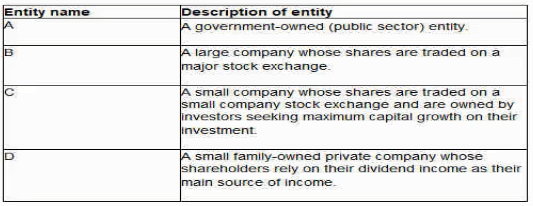CIMA F3 - Financial Strategy
VVV has a floating rate loan that it wishes to replace with a fixed rate. The cost of the existing loan is the risk-free rate + 3%. VW would have to pay a fixed rate of 7% on a fixed rate loan VVVs bank has found a potential counterparty for a swap arrangement.
The counterparty wishes to raise a variable rate loan It would pay the risk-free rate +1 % on a variable rate loan and 8% on a fixed rate.
The bank will require 10% of the savings from the swap and WV and the counterparty will share the remaining saving equally.
Calculate VWs effective rate of interest from this swap arrangement.
The directors of the following four entities have been discussing dividend policy:

Which of these four entities is most likely to have a residual dividend policy?
Company P is a pharmaceutical company listed on an alternative investment market. Â
The company is developing a new drug which it hopes to market in approximately six years' time.
Company P is owned and managed by a group of doctors who wish to retain control of the company. The company operates from leased laboratories with minimal fixed assets.Â
Its value comes from the quality of its research staff and their research.
The company currently has one approved drug which generates sufficient cashflow to cover day to day operations but not sufficient for major new research and development.
Company P wish to raise debt finance to develop the new drug.Â
Â
Recommend which of the following types of debt finance would be most appropriate for Company P to help finance the development of this new drug.Â
Company A is unlisted and all-equity financed. It is trying to estimate its cost of equity.Â
Â
The following information relates to another company, Company B, which operates in the same industry as Company A and has similar business risk:
Â
Equity beta = 1.6Â Â Â Â Â Â
Debt:equity ratio 40:60
The rate of corporate income tax is 20%.
The expected premium on the market portfolio is 7% and the risk-free rate is 5%.
What is the estimated cost of equity for Company A?
Â
Give your answer to one decimal place.
Â
 ? %Â
PPA owns $500,000 of shares in Company ABB. Company ABB has a daily volatility of 2% of its share price
Calculate the 12-day value at risk that shows the most PPA can expect to lose during a 12-day period (PPA wishes to be 90% certain that the actual loss in any month will be less than your predicted figure)
Give your answer to the nearest thousand dollars.

A company has accumulated a significant amount of excess cash which is not required for investment for the foreseeable future.
It is currently on deposit, earning negligible returns.
Â
The Board of Directors is considering returning this excess cash to shareholders using a share repurchase programme.
The majority of shareholders are individuals with small shareholdings.
Â
Which THREE of the following are advantages of the company undertaking a share repurchase programme?Â
A large, listed company in the food and household goods industry needs to raise $50 million for a period of up to 6 months.
It has an excellent credit rating and there is almost no risk of the company defaulting on the borrowings. The company already has a commercial paper programme in place and has a good relationship with its bank.
Â
Which of the following is likely to be the most cost effective method of borrowing the money?
A company's latest accounts show profit after tax of $20.0 million, after deducting interest of $5.0 million. The company expects earnings to grow at 5% per annum indefinitely.Â
Â
The company has estimated its cost of equity at 12%, which is included in the company WACC of 10%.
Â
Assuming that profit after tax is equivalent to cash flows, what is the value of the equity capital?
Â
Give your answer to the nearest $ million.
Â
$ Â ? Â millionÂ
Company GDD plans to acquire Company HGG, an unlisted company which has been in business for 3 years.
Company HGG has incurred losses in its first 3 years but is expected to become highly profitable in the near future
There are no listed companies in the country operating in the same business field as Company HGG The future success of Company HGG's business and hence the future growth rate in earnings and dividends is difficult to determine
Company GDD is assessing the validity of using the dividend growth method to value Company HGG
Which THREE of the following are weaknesses of using the dividend growth model to value an unlisted company such as Company HGG?
Company RRR is a well-established, unlisted, road freight company.
In recent years RRR has come under pressure to improve its customer service and has had some success in doing this However, the cost of improved service levels has resulted in it making small losses in its latest financial year. This is the first time RRR has not been profitable.
RRR uses a 'residual' dividend policy and has paid dividends twice in the last 10 years.
Which of the following methods would be most appropriate for valuing RRR?



